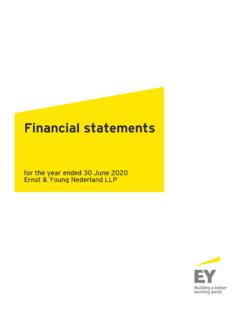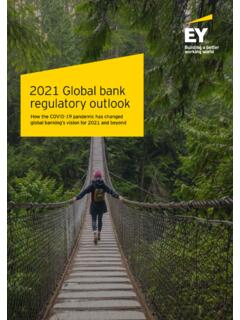Transcription of Guide to going public - EY
1 Guide to going public Strategic considerations before, during and post-IPO. Contents going public Situations, cases and motivations 3. pros and cons of going public 6. IPO success factors and challenges 7. IPO process and EY's IPO value journey 9. IPO value journey Phase 1: Strategic considerations and IPO planning 11. 12 24 months before IPO. Phase 2: IPO preparation 26. 6 12 months before IPO. Phase 3: IPO transaction 34. 1 6 months before IPO. Phase 4: Being public 42. Post-IPO. EY with you all the way 48. Contacts 50. 1 | Guide to going public Foreword For private companies seeking to raise capital and capital-held companies considering their strategic options for funding for provide exits for their shareholders, an initial public growth, including a public listing.
2 We have professionals with extensive, proven experience with domestic and international capital markets. Our offering (IPO) can be a superior route and strategic professionals have deep knowledge of your industry, which allows us to option to funding growth and to access deep pools of create interdisciplinary teams that will steer you onward, through and liquidity. While challenging markets will come and go, beyond your IPO and support your plans for growth. it's the companies that are fully prepared that will We are confident this Guide to going public will give you an initial overview best be able to create value and fully leverage the and checklists of the key phases in going public from a global perspective.
3 IPO windows of opportunity whenever they are open. It is based on EY insights from many IPO transactions, to help you begin your IPO value journey, so that you are well prepared to transform your The companies that Companies that have completed a successful IPO know the process private company into a successful public company that continually delivers involves the complete transformation value to its shareholders. With more than 30 years' experience helping are fully prepared will be of the people, processes and culture of the organization from a private companies prepare, grow and adapt to life as a public entity, we are well- suited to take you on your IPO journey providing tailored support and able to create value and enterprise to a public one.
4 Preparation integrated services before, during and after your IPO. is critical. Successful IPO candidates Our IPO leaders in your region and our global network will serve you from fully leverage the IPO. often spend two years or more evaluating strategic options pre-IPO to setting you on the right path to building business processes and support growth post-IPO, while anticipating the expectations of various infrastructure, recruiting executive parties including regulatory boards, the financial community, the press windows of opportunity. and advisory talent, getting in front of financial and reporting issues and and investors along the way.
5 Irrespective of your market or region, we look forward to exploring with you mastering the essential board of the various strategic options and each facet of your IPO value journey. directors' commitment to go public . During the journey to become a public company, an organization must prepare not only for the defining moment of the IPO ceremony, the ringing of the bell, but also for a whole new phase EY IPO Leaders of corporate life after the IPO takes place. That's why market outperformers treat the IPO as a long-term transformational process. EY is a key member of your external IPO team.
6 We have worked with business owners and management teams of family businesses, scaled up and high-growth companies as well as private equity- or venture 2 | Guide to going public going public What to do when you see an IPO on the horizon. Situations, cases and motivations Why would you conduct an IPO? An IPO is the first sale of a company's shares to the public and the listing of shares on a stock exchange. It allows a company to raise capital in order to build its business by creating newly issued shares and selling existing shares. There are many situations when companies start to evaluate an IPO.
7 As one of their strategic options. Funding or exit motivations, growth, internationalization and changes in the respective industry are triggers for strategic considerations around an IPO. Depending on the stakeholder, a mix of situations and motivations can lead to initial IPO. considerations. 3 | Guide to going public going public Typical contexts for companies that go public Typical IPO case studies are: Figure 1: Typical contexts for companies that go public High-growth companies: IPO to fund innovation, growth, acquisitions and internationalization Private equity (PE) and venture capital (VC) owners: IPO as a way to exit and to further fund growth of portfolio companies Family business the company: IPO as integral part of the succession PE/VC: e xit plan and to separate management and ownership Strong company pressure.
8 Family business the owner: IPO to diversify wealth and to better growth and maturity manage succession Scale-up companies: IPO as a way to better attract talent and to incentivize management Conglomerates: IPO as a transaction to carve out and partial or full exit of business units consolidation . State-owned entities: IPO to privatize trends IPO o f competitors Company situation First mover Front runner and and innovator industry disruptor Next generation/ New openness . successor and public awareness 4 | Guide to going public going public Typical motivations for going public For many companies that have just started to consider going public , the Figure 2: Typical motivations for going public key question is: could an IPO be the right next step?
9 The preparation starts with the careful evaluation of pros and cons of an IPO, the potential use of proceeds and examination of alternatives. This is in line with the first questions from investors at an IPO road show: why are you going public and what is the use of IPO proceeds? Answering Improved . these fundamental questions is key to the success of an IPO. Increased b rand standing/ credit- . A successful listing can help your company unlock access to financing awareness worthiness to complete a strategic acquisition, create opportunities to expand your business into new markets or provide an exit opportunity for your private equity or other investors.
10 In addition, it can also improve perceptions of your business and brand with customers, suppliers and employees. Improved . While not all businesses are suited for life in the public eye, for many Partial exit f or appeal as an . fast-growing private companies, an IPO can raise the capital needed to current o wners accelerate growth and achieve market leadership. employer IPO. The best reason to go public isn't to exit. Separation o f It isn't to get the going - public experience. Strengthen . management It's because it's the right step in the path equity on which you're guiding your company.











